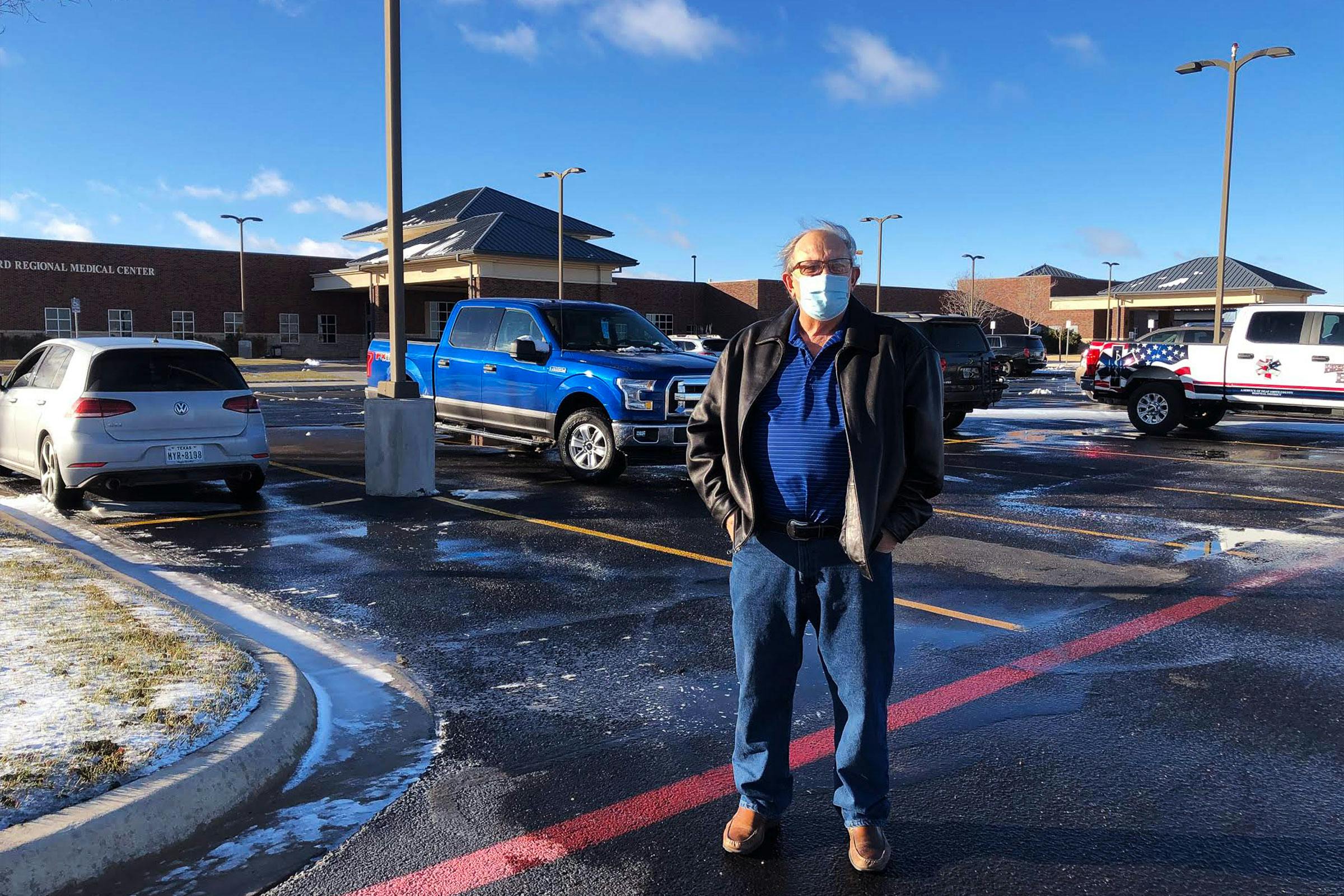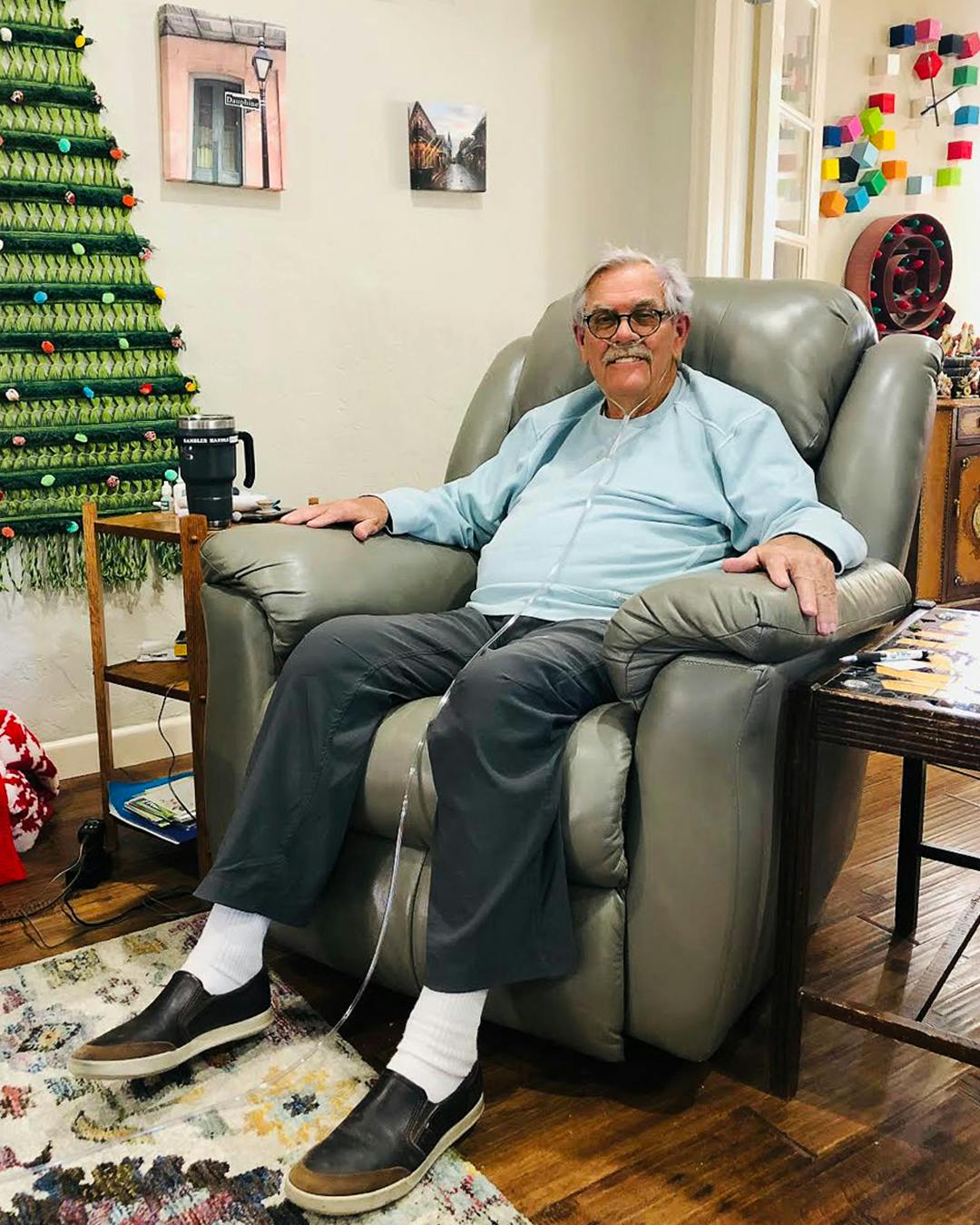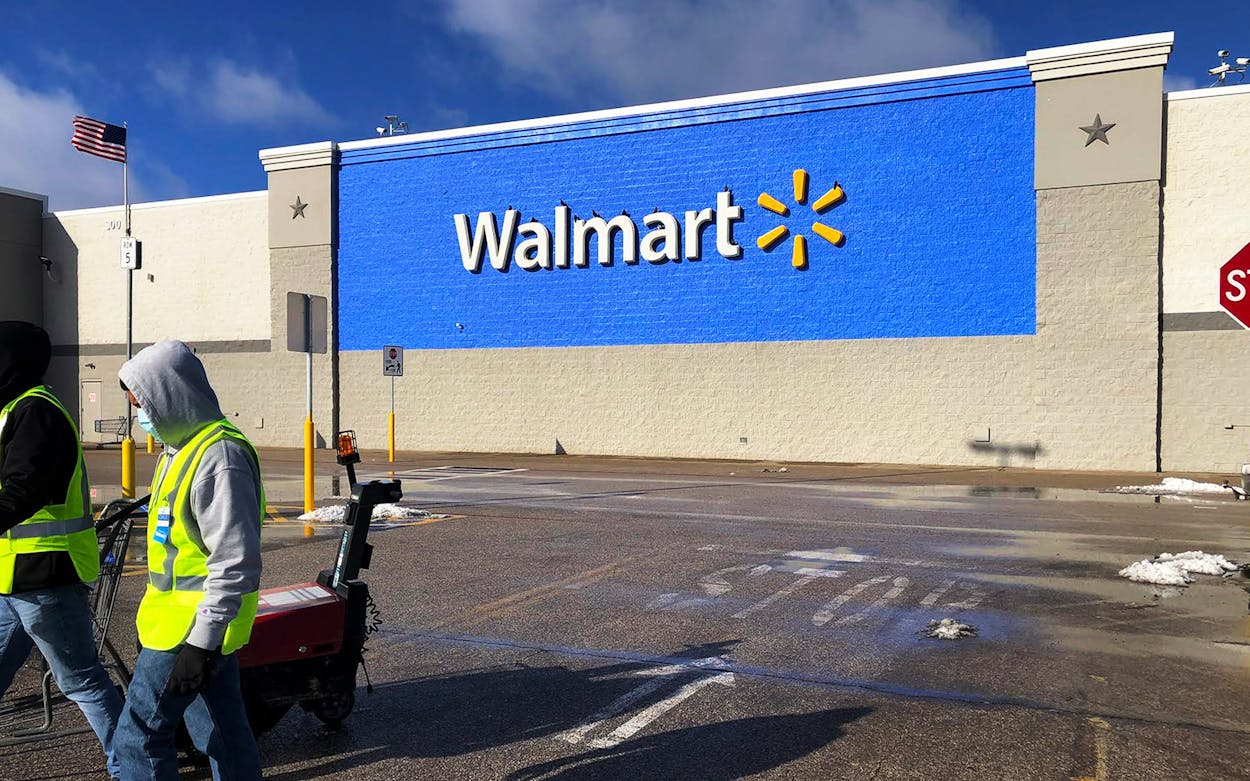The Walmart Supercenter in the Texas Panhandle community of Hereford sits on the northwest edge of town like an immense, retail rampart marking the border of civilization. Beyond the store, a flat expanse of farmland stretches out for hundreds of miles, all the way to the foothills of the Rocky Mountains. Other than church and a high school sports arena, the store is probably the only place in town where hundreds, if not thousands, of area residents regularly gather.
But for months now, entering the Walmart has become a hazard of daily life that is talked about by some in Hereford like a dangerous stretch of road. Near boxes of marked-down holiday toys, a sign at the store entrance informs customers that mask wearing is mandatory, and regular recordings over the loudspeaker broadcast the same message. Store employees all wear face coverings and some sport badges urging social distancing. But one recent afternoon, roughly a quarter of the shoppers—more than fifty people—in the crowded store were maskless, often in close proximity to elderly customers and others using motorized shopping carts. Some store employees looked exasperated. Others looked terrified. At no point did they appear to make an effort to enforce basic health protocols, such as asking customers to wear masks. On three more occasions at different times of day, the same patterns emerged. One afternoon, an elderly man without a mask limped past Walmart “health ambassadors” before pulling a tissue from his jacket, blowing his nose, and grabbing a shopping cart. Nobody said a word or tried to offer him a face covering.
Perusing store aisles for even a few minutes, it is difficult to avoid maskless customers. Working inside the store for extended periods makes that task virtually impossible. This year, during his eight-hour-long shifts at the Hereford Walmart, Bernie Witt, a 73-year-old sales associate, sensed he was in danger. How much danger, however, was never entirely clear to him. “They don’t make everyone wear masks and they don’t tell you if someone you work with gets sick, so you never know how bad things really are,” Witt told me last week. In October, after months of brushing up against maskless customers inside the store’s narrow aisles, Witt found himself lying in a hospital bed down the street at the Hereford Regional Medical Center, a bad case of COVID-19 turning his lungs into “concrete.” A cancer survivor, Witt was eventually transferred to a hospital in nearby Plainview, where he managed to survive. But he’s been left with a $180,000 medical bill, and because of lung damage he can no longer lift fifty pounds, a requirement for most Walmart jobs.

“I think I gave it to the whole First Baptist Church,” Witt said, referring to a period when he may have been contagious but hadn’t developed symptoms. “We’ve had tons of people die at the church and the Methodist church is the same way. I feel sorry because I talked to everybody at both churches.”
Another Walmart employee, a longtime veteran of the Hereford store who asked to have her name withheld for fear of losing her job, said pronouncements made over the loudspeaker inside the store about employees taking extra precautions are “bull crap.” Though store employees are supposed to spray carts and shelves with an antibacterial liquid, she said, it rarely happens.
The laissez-faire attitude in the store stands in stark contrast to the scene down the street. A few hundred feet away, across an empty lot about two football fields wide, a team of doctors and nurses at the Hereford Regional Medical Center are under siege. By any reasonable measure, Hereford, the seat of Deaf Smith County, is in the throes of a humanitarian crisis, one that health experts believe is likely to worsen in the coming weeks. Like so many other rural Texas communities, the dusty, hardscrabble town of 15,000 about fifty miles southwest of Amarillo, has struggled to contain the coronavirus. At the end of November, Deaf Smith County became the epicenter of one of the worst COVID-19 spikes, helping to make it the seventh-hardest hit county per capita in Texas. In all, more than 12 percent of residents have tested positive for COVID-19, more than double the statewide rate.
Though Walmart is the most visible symbol of the town’s casual attitude toward the pandemic, it’s hardly the only one. Maskless customers fill cramped restaurants and crowd grocery store aisles. They pack the bleachers at volleyball games and trade hellos at feed stores. “I believe Walmart is the catalyst,” the veteran employee said, referring to the outbreak in Hereford. “But you know, the people that went to Walmart also go to Amigos, go to Food King, go here, go there.”
With state contact tracers overwhelmed by the sheer number of outbreaks and with no county health department to map the virus’s spread, nobody in Hereford can be entirely sure what is primarily responsible for its proliferation, though the dangers of stepping inside the Walmart is an open secret among local leaders and health-care professionals. There is no question, however, that the virus is spreading.
COVID-19 has run rampant through restaurants and meatpacking plants, the economic heart of Hereford, which calls itself the “Beef Capital of the World.” It has torn through local churches and the Hereford ISD, the city’s largest employer. About fifty locals, including Hereford’s 85-year-old former mayor, have died from it—almost half in the last month. At Parkside Chapel Funeral Directors, which recently ran out of guest books for loved ones to sign, a manager told me they’d received ten “death calls” over the past two weeks. Most years, it might take three or four months to reach the same number.
“It’s really been a bad, bad run,” Tom Simons, the 77-year-old mayor of Hereford who spent eleven days in the hospital with the virus, told me. Unable to work, he spends his days at home, sitting in a recliner with an oxygen tube in his nostrils, and he noted that he has three friends in the hospital right now recovering from tracheostomies. “Our numbers have skyrocketed in recent weeks and, like any place, I think there’s more people who have had it than have been counted.”
In a single evening two weeks ago, the number of patients in the 42-bed Hereford Regional Medical Center jumped from twelve to twenty. In response, the Department of State Health Services installed a medical tent that remains outside the building for the hospital’s non-COVID-19 patients.
As the middle of the month rolled around, new coronavirus patients exposed during Thanksgiving weekend arrived daily at the intensive care unit. Some patients have been so ill that hospital staff has begun transferring them to Albuquerque, Dallas, Tulsa, and as far away as Kansas City, where they’re more likely to receive specialized treatment. So far in December, the Hereford EMS has received 200 calls—almost all connected to COVID-19 symptoms—well above the usual average of around 120. “My biggest fear is that we’re going to be full in the regular hospital and full in the ER, and I’ll have ambulances sitting outside the building with patients in them and nowhere to go,” Jeff Barnhart, the medical center’s CEO, told me during a tour of the Hereford Regional Medical Center earlier this month.

I wanted to better understand why, in a town in which everyone seemed able to name multiple acquaintances who had contracted the virus, and often someone who had been hospitalized or died, so many were still reluctant to take precautions and many businesses weren’t enforcing COVID-19 restrictions.
When asked about the Hereford Walmart, a spokesperson for the national chain told Texas Monthly via email that all locations are required to follow the same health and safety guidelines, which require employees and customers to wear masks. The spokesperson noted that at stores’ front entrances the company has also posted signs emphasizing the importance of face coverings and placed a “health ambassador” to “encourage the use of facial coverings.” “Health ambassadors will not confront customers or block their entrance from the store, or deny service,” the spokesperson wrote. “They have received de-escalation training in the event of a customer becomes unreasonable. Store management is working with local law enforcement to understand how to best partner with them on any concerns that arise as a result of the local/state face covering mandate.”
Asked to respond to claims that the Hereford store doesn’t inform employees when their colleagues have contracted the virus, the spokesperson said that the company always encourages “associates to use our open door policy to discuss matters with any member of management.” Asked what actions the company might take when a store fails to implement safety guidelines, the spokesperson declined to comment. “We do not comment on internal policies,” the spokesperson wrote.
With the Hereford Walmart seemingly unwilling to force customers to wear masks, the onus has shifted to the local community. This has presented a conundrum for anyone trying to remain virus-free, because many Hereford residents profess to have little concern about the health crisis.
At a gift shop about two miles from the Walmart, an elderly woman working the counter, who put on a mask when I arrived, told me she doesn’t think much about contracting COVID-19, even though she knows multiple locals from church who’ve gotten the virus and at least five who’ve died. When pressed to explain why she’s not concerned, she struggled to respond. “People are just going about their daily lives,” she finally told me. “I just don’t really think about it.”
All over town, residents had similar stories. At the county museum, an employee told me she and her husband can’t seem to agree on whether the pandemic exists at all, despite the fact that she contracted, and later recovered from, the virus. Another local, Donavan Diaz, told me that some in town have latched on to a conspiracy theory: that his business, and the hospital, are involved in an effort to exaggerate the death toll for money. It’s a curious claim considering that Diaz is a manager at Parkside Chapel Funeral Directors and those offering the conspiracy have been in his presence because a loved one succumbed to the virus.
Richard LaMascus, an outspoken, award-winning history teacher at Hereford High School, told me he had been a “compliant but vocal resistor” of lockdowns and mask wearing last spring. If the virus had any impact, he reasoned, it would likely mimic H1N1, another global pandemic that caused mass cancellations in Hereford but had little impact on the town. At the time, he didn’t know anyone who’d contracted COVID-19 and he was upset that so many student events, including an annual University Interscholastic League (UIL) academic competition he coaches, were canceled for a nearly nonexistent threat.
After months of unhappily donning a mask, LaMascus’s perspective changed when he attended a two-hundred-person wedding without his mask this fall and became sick, later infecting his wife. “I learned my lesson,” the 57-year-old said, noting that two months into his recovery he still can’t taste or smell and his wife, a choir teacher, hasn’t been able to sing again.
Barnhart is still struggling to come to terms with those who deny the virus. He blames the mistrust of medical authorities on a flood of misinformation on Facebook, fueled by national politicians. On regional radio programs, broadcasters downplay the pandemic death toll, misrepresent science, and claim government restrictions have trampled on the Bill of Rights. “I’ve told people before, ‘Tell me about the science behind what you’re telling me,’” he said. “The last person told me, ‘I can’t because I don’t have any.’”
“It’s frustrating,” he added. “You want to tell people to come spend a day with us here and see what we see.”

The behavior has confused other longtime residents. Hereford has always viewed itself as a close-knit community rooted in trust, a place where Simons says a handshake is still considered as good as a contract in some circles. When a home on her in-laws’ block burned down some years ago, Marissa Cooney remembers an outpouring of support from neighbors. The local motto, “Hereford Strong”—a phrase currently plastered on storefronts across town—felt like it was grounded in a shared reality.
But, now the 27-year-old Cooney says she’s found herself in heated arguments on Facebook and the grocery store with locals who claim the pandemic is overblown. She suspects she caught the virus from a coworker who refuses to wear a mask. Her aunt was killed by the virus last month, and her aunt’s husband, also a COVID-19 victim, was finally taken off life support last week.
“We’re used to this community doing the Christian thing of taking care of their neighbors,” Cooney said. “But right now a lot of people in Hereford have this disconnect, because if it’s not happening to them or someone they care about, it doesn’t matter.”
As hard as it is for Cooney to admit, she says her recently deceased loved ones, Debbie Puente, 64, and Roy Puente, 64, were among those Hereford residents who didn’t react to the pandemic with alarm. Both had some preexisting medical issues but they continued traveling to high school football games—one of their favorite outings—often without masks. In October, both fell ill and were quickly intubated.
The couple’s children dispute the idea that their parents weren’t cautious. As the pandemic took hold last spring, Leslie Puente, who lives in Fort Worth, said, her parents “began to buy sanitizer, home disinfectant, and supplies like everyone across the state did,” adding that she found KN95 masks among her parents’ belongings. “We understand that there are those who feel my parents may not have taken this seriously, but we as their kids, as well as others, know deep down they did.”
Doctors and nurses provided the Puentes’ three adult children with regular updates about the couple’s condition, but other members of the extended family said they received limited information from health-care workers and were never able to speak to Roy or Debbie again, a source of anguish. The Puentes leave behind six grandchildren.
“There’s no closure,” Debbie’s sister, Rebecca Lindauer, told me, her eyes filling with tears. “It’s like my sister just vanished one day.”
The last person to see Debbie and Roy out and about in Hereford was Bernie Witt, the Walmart employee who was nearly killed by the virus a few weeks later. Witt had gotten to know the couple because Debbie’s sister, Rebecca, was his longtime manager at the store. The couple had approached him at work asking for her. Roy looked healthy, Witt recalls, but Debbie’s energy seemed low. “I had my mask on, but they weren’t wearing masks,” Witt recalled. “In the back of my mind it bugged me, but I didn’t say anything. Now I wonder what might have happened if I had.”
Update: This article has been updated to include additional context on Debbie and Roy Puente’s final days and to correct Roy’s age. A previous version of the story reported that family members had limited contact with the hospitals where the Puentes received care.
- More About:
- Politics & Policy
- Health
- Pandemic








